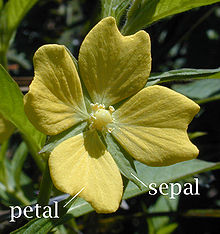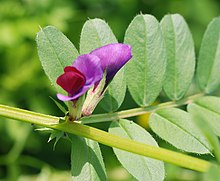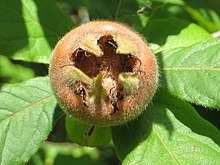This articlemay be too technical for most readers to understand.(February 2021) |
Asepal(/ˈsɛpəl,ˈsiːpəl/)[1][2][3]is a part of theflowerofangiosperms(flowering plants). Usually green, sepals typically function as protection for the flower in bud, and often as support for thepetalswhen in bloom.[4]





Etymology
editThe termsepalumwas coined byNoël Martin Joseph de Neckerin 1790, and derived fromAncient Greekσκέπη(sképē)'covering'.[5][6]
Collectively, the sepals are called thecalyx(plural: calyces),[7]the outermostwhorlof parts that form a flower. The wordcalyxwas adopted from the Latincalyx,[8]not to be confused withcalix'cup, goblet'.[9]The Latincalyxis derived from Greekκάλυξkalyx'bud, calyx, husk, wrapping' (cf.Sanskritkalika'bud'),[10]whilecalixis derived from Greekκύλιξkylix'cup, goblet'; both words have been used interchangeably in botanical Latin.[11]
Description
editThe termtepalis usually applied when the parts of theperianthare difficult to distinguish,[12]e.g. the petals and sepals share the same color or the petals are absent and the sepals are colorful. When the undifferentiated tepals resemble petals, they are referred to as "petaloid", as inpetaloid monocots,orders of monocots with brightly colored tepals. Since they includeLiliales,an alternative name is lilioid monocots. Examples of plants in which the term tepal is appropriate include genera such asAloeandTulipa.In contrast, genera such asRosaandPhaseolushave well-distinguished sepals and petals.[citation needed]
The number of sepals in a flower is itsmerosity.Flower merosity is indicative of a plant's classification. The merosity of aeudicotflower is typically four or five. The merosity of amonocotorpalaeodicotflower is three, or a multiple of three.
The development and form of the sepals vary considerably amongflowering plants.[13]They may be free (polysepalous) or fused together (gamosepalous).[14]Often, the sepals are much reduced, appearing somewhatawn-like, or as scales, teeth, or ridges. Most often such structures protrude until the fruit is mature and falls off.
Examples of flowers with much-reduced perianths are found among thegrasses.
In some flowers, the sepals are fused towards the base, forming acalyx tube(as in the familyLythraceae,[15]andFabaceae). In other flowers (e.g., Rosaceae, Myrtaceae), ahypanthiumincludes the bases of sepals, petals, and the attachment points of thestamens.
Mechanical cues may be responsible for sepal growth and there is a strong evidence suggesting that microtubules are present and determine the tensile strength and direction of growth at a molecular level.[16]
Morphology
editMorphologically,both sepals and petals are modified leaves. The calyx (the sepals) and the corolla (the petals) are the outer sterile whorls of the flower, which together form what is known as theperianth.[17]In some plants, such asAristolochia,the calyx is the primary whorl, forming a flower up to 20 inches (51 cm) wide, with one sepal growing to a length of 13 feet (4.0 m) –Aristolochia grandiflora,the largest of all calyces.[18][19]
Function
editSimilarly to ordinary leaves, sepals are capable of performingphotosynthesis.However, photosynthesis in sepals occurs at a slower rate than in ordinary leaves due to sepals having a lowerstomataldensity which limits the spaces for gas exchange.[20]
After flowering, most plants have no more use for the calyx which withers or becomes vestigial, although in a few plants such asLodoiceaandeggplant(Solanum melongena) the calyx grows along with the fruit, possibly to protect the attachment point. Some plants retain a thorny calyx, either dried or live, as protection for the fruit or seeds. Examples include species ofAcaena,some of theSolanaceae(for example theTomatillo,Physalis philadelphica), and thewater caltrop,Trapa natans.In some species, the calyx not only persists after flowering but instead of withering, begins to grow until it forms a bladder-like enclosure around the fruit. This is an effective protection against some kinds of birds and insects, for example inHibiscus trionumand theCape gooseberry.In other species, the calyx grows into anaccessory fruit.
See also
editReferences
edit- ^From Frenchsépale,fromNeo-Latinsepalum,a blend ofsep-from Greekskepē'covering' and-alumfrom Neo-Latinpetalum'petal', influenced by Frenchpétale'petal'.
- ^"Oxford Languages | The Home of Language Data".languages.oup.
- ^"sepal".CollinsDictionary.HarperCollins.
- ^Beentje, Henk (2010).The Kew Plant Glossary.Richmond, Surrey:Royal Botanic Gardens, Kew.ISBN978-1-84246-422-9.,p. 106
- ^Stearn, William T. (2000). Botanical Latin, 4th ed.: 38-39.ISBN0-88192-321-4
- ^Necker, N.J. de (1790).Corollarium ad Philosophiam botanicam Linnaei 18,31
- ^Shorter Oxford English dictionary, 6th ed.United Kingdom: Oxford University Press. 2007. p. 3804.ISBN978-0199206872.
- ^Jackson, Benjamin, Daydon; A Glossary of Botanic Terms with their Derivation and Accent; Published by Gerald Duckworth & Co. London, 4th ed 1928
- ^John Entick, William Crakelt, Tyronis thesaurus, or, Entick's new Latin English dictionary. Publisher: E.J. Coale, 1822
- ^Tucker, T. G. (1931).A Concise Etymological Dictionary of Latin.Halle (Saale): Max Niemeyer Verlag.
- ^Stearn, William T. (2000). Botanical Latin, 4th ed.: 38
- ^Beentje 2010,p. 119
- ^Sattler, R. 1973.Organogenesis of Flowers. A Photographic Text-Atlas.University of Toronto Press.ISBN0-8020-1864-5.
- ^Beentje 2010,pp. 51 & 91.
- ^Carr, Gerald."Lythraceae".University of Hawaii. Archived fromthe originalon 5 December 2008.Retrieved20 December2008.
- ^Hervieux, Nathan; Dumond, Mathilde; Sapala, Aleksandra; Routier-Kierzkowska, Anne-Lise; Kierzkowski, Daniel; Roeder, Adrienne H.K.; Smith, Richard S.; Boudaoud, Arezki; Hamant, Olivier (April 2016)."A Mechanical Feedback Restricts Sepal Growth and Shape in Arabidopsis".Current Biology.26(8): 1019–1028.Bibcode:2016CBio...26.1019H.doi:10.1016/j.cub.2016.03.004.hdl:11858/00-001M-0000-002B-1620-2.PMID27151660.
- ^Davis, P.H.; Cullen, J. (1979).The identification of flowering plant families, including a key to those native and cultivated in north temperate regions.Cambridge: Cambridge University Press. p. 106.ISBN0-521-29359-6.
- ^Rohwer, Jens G. (2002).Tropical Plants of the World.New York: Sterling. p. 208.
- ^Pfeifer, HW (November 1966)."Revision of the North and Central American Species of Aristolochia".Annals of the Missouri Botanical Garden.53(2): 164.doi:10.2307/2394940.JSTOR2394940.
- ^Aschan, G.; Pfanz, H.; Vodnik, D.; Batič, F. (1 March 2005)."Photosynthetic performance of vegetative and reproductive structures of green hellebore (Helleborus viridis L. agg.)".Photosynthetica.43(1): 55–64.doi:10.1007/s11099-005-5064-x.S2CID24426595.